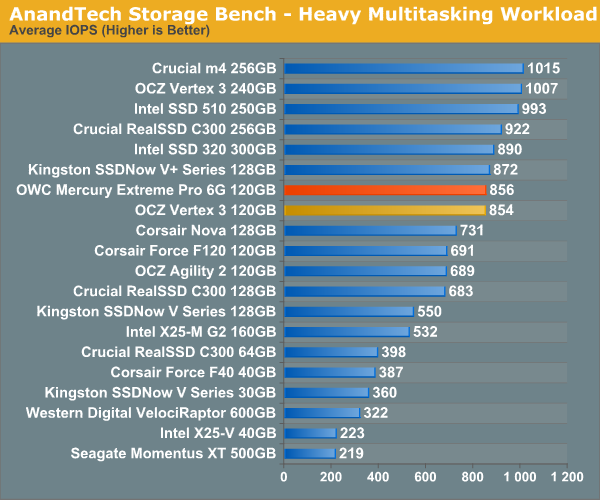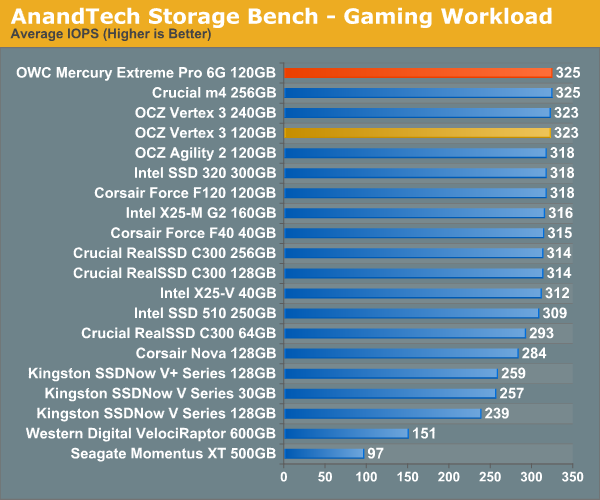OWC Mercury Extreme Pro 6G SSD Review (120GB)
by Anand Lal Shimpi on May 5, 2011 1:45 AM ESTAnandTech Storage Bench 2010
To keep things consistent we've also included our older Storage Bench. Note that the old storage test system doesn't have a SATA 6Gbps controller, so we only have one result for the 6Gbps drives.
The first in our benchmark suite is a light/typical usage case. The Windows 7 system is loaded with Firefox, Office 2007 and Adobe Reader among other applications. With Firefox we browse web pages like Facebook, AnandTech, Digg and other sites. Outlook is also running and we use it to check emails, create and send a message with a PDF attachment. Adobe Reader is used to view some PDFs. Excel 2007 is used to create a spreadsheet, graphs and save the document. The same goes for Word 2007. We open and step through a presentation in PowerPoint 2007 received as an email attachment before saving it to the desktop. Finally we watch a bit of a Firefly episode in Windows Media Player 11.
There’s some level of multitasking going on here but it’s not unreasonable by any means. Generally the application tasks proceed linearly, with the exception of things like web browsing which may happen in between one of the other tasks.
The recording is played back on all of our drives here today. Remember that we’re isolating disk performance, all we’re doing is playing back every single disk access that happened in that ~5 minute period of usage. The light workload is composed of 37,501 reads and 20,268 writes. Over 30% of the IOs are 4KB, 11% are 16KB, 22% are 32KB and approximately 13% are 64KB in size. Less than 30% of the operations are absolutely sequential in nature. Average queue depth is 6.09 IOs.
The performance results are reported in average I/O Operations per Second (IOPS):

If there’s a light usage case there’s bound to be a heavy one. In this test we have Microsoft Security Essentials running in the background with real time virus scanning enabled. We also perform a quick scan in the middle of the test. Firefox, Outlook, Excel, Word and Powerpoint are all used the same as they were in the light test. We add Photoshop CS4 to the mix, opening a bunch of 12MP images, editing them, then saving them as highly compressed JPGs for web publishing. Windows 7’s picture viewer is used to view a bunch of pictures on the hard drive. We use 7-zip to create and extract .7z archives. Downloading is also prominently featured in our heavy test; we download large files from the Internet during portions of the benchmark, as well as use uTorrent to grab a couple of torrents. Some of the applications in use are installed during the benchmark, Windows updates are also installed. Towards the end of the test we launch World of Warcraft, play for a few minutes, then delete the folder. This test also takes into account all of the disk accesses that happen while the OS is booting.
The benchmark is 22 minutes long and it consists of 128,895 read operations and 72,411 write operations. Roughly 44% of all IOs were sequential. Approximately 30% of all accesses were 4KB in size, 12% were 16KB in size, 14% were 32KB and 20% were 64KB. Average queue depth was 3.59.

The gaming workload is made up of 75,206 read operations and only 4,592 write operations. Only 20% of the accesses are 4KB in size, nearly 40% are 64KB and 20% are 32KB. A whopping 69% of the IOs are sequential, meaning this is predominantly a sequential read benchmark. The average queue depth is 7.76 IOs.











44 Comments
View All Comments
taltamir - Thursday, May 5, 2011 - link
doesn't the Z version let you access the CPU's video decoding/encoding engine while having an external GPU?While with the P and H versions you have to choose one or the other?
jb510 - Friday, May 6, 2011 - link
In considerin an SSD for an OS X boot volume should one be more concerned with compressible data or incompressible data? I wondering because I know OS X compreses some of it's OS files and presumably many apps do the same thing. Further I'm assuming the light workload test uses a windows simulation, can anyone say if/how that would differ from OS X?I'm probably more worried about it than I need to be but trying to decide between OCZ/OWC, Intel and Crucial and still not clear which is best for a dual drive setup in a MacBook pro.
zilab - Saturday, June 4, 2011 - link
"OCZ is still SandForce's favorite partner and thus it gets preferential treatment when it comes to firmware."I just confirmed with OWC, they're shipping the 6G with the 60K IOPS read/write frimware. Hope you update your article soon. This is kinda misleading, I'm reading comments here and people think that only OCZ drives have the 60K IOPS firmware.
nish0323 - Wednesday, June 15, 2011 - link
I had the Crucial C300, OCZ Vertex 3, and the OWC Extreme 6G in my laptop on a Sata6G connection... and honestly I didn't notice a difference in speed between the three of them. Against the Vertex 2 and the Intel X-25, there was a slight difference. In the end, I decided to go with OWC Extreme 6G for one reason... **** FIVE YEAR WARRANTY ****!!! That's friggin' awesome... ONLY SSD to offer a 5 year warranty on an SSD. And costwise, they're around the same or lower as the rest of the competition.